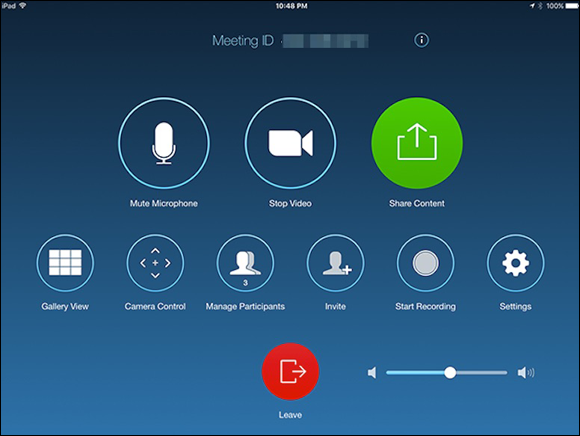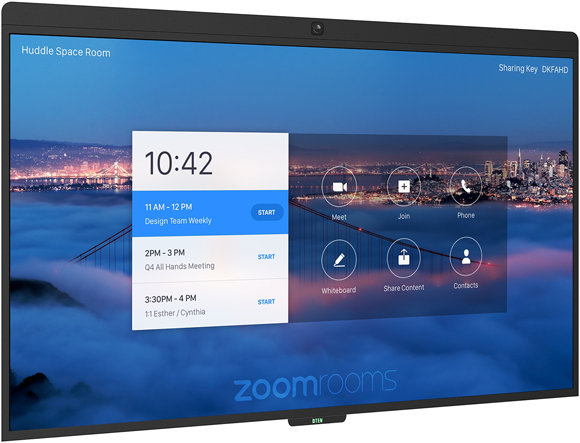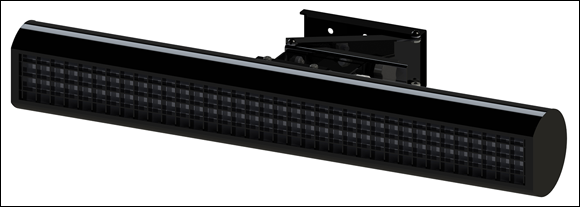Chapter 10
Taking Group Meetings to the Next Level with Zoom Rooms
IN THIS CHAPTER
 Understanding immersive-telepresence technology
Understanding immersive-telepresence technology
 Covering the basic features of Zoom Rooms
Covering the basic features of Zoom Rooms
 Reviewing hardware, software, and lighting considerations
Reviewing hardware, software, and lighting considerations
Meetings & Chat serves a valuable purpose: It allows individuals to hold videoconferencing calls with anyone on the globe with their computers, tablets, and smartphones. Put differently, meeting hosts and participants just install Zoom software on their existing devices and get to work.
But what if an organization’s videoconferencing needs exceed letting people dial in from their own individual devices? That is, a company wants to hold its video meetings with groups of people in the same physical location. Doing so would let remote attendees feel like they’re in the same room as their peers.
For this reason, Zoom offers a popular service that takes Meetings & Chat up several notches: Zoom Rooms.
Revisiting the Early Days of Immersive-Telepresence Technology
It turns out that the idea of fusing high-tech software and hardware together to provide ginned-up conference rooms, corporate meetings, and training sessions isn’t exactly new. In fact, the idea behind contemporary immersive-telepresence technology dates back to the early 1990s.
Put it this way: Say that one group of suits was in São Paulo, Brazil while the other was in Montreal, Canada. If both groups were using immersive-telepresence technology, then people in each cohort would feel like they were actually in the same physical room.
How does the magic behind immersive-telepresence technology happen? I asked that very question to Jeff Fillbrandt of Utelogy, a company that builds tools that let people manage their audio-visual setups. The two of us spoke in early April 2020 — via Zoom, of course. Fillbrandt told me that Lifesize, Polycom, and other early immersive-telepresence vendors created this effect by installing three large, high-tech video screens next to each other. At the risk of oversimplifying, those screens and the software behind them created the illusion that people in Room A were sitting across from the people in Room B.
TelePresence by Cisco Systems
Arguably the highest profile product launch in the category took place in October 2006. Cisco announced the release of TelePresence, a suite of products that linked two physically separated rooms in a tighter way than people previously thought possible. Ideally, thanks to TelePresence, two conference rooms would resemble a single, integrated one despite their disparate locations.
To be sure, the idea behind TelePresence made plenty of sense. After all, the web had been around for more than a decade at that point. Generally speaking, new technologies were starting to make the impossible possible or, if you like, flatten the world. Thomas L. Friedman makes that point in spades in his 2005 book The World Is Flat: A Brief History of the Twenty-first Century (Farrar, Straus and Giroux).
Brass tacks: The time was ripe for Cisco Systems and other large technology vendors to take their first-generation immersive-telepresence tools to the next level. Cisco’s execs envisioned the company’s TelePresence in organizations’ boardrooms and classrooms across the globe.
In 2008, Cisco claimed that it had outfitted 2,000 rooms with its wares. Beyond its paid customers, the company used the tool itself and commendably donated dozens of units to philanthropic organizations.
Unfortunately for Cisco, TelePresence never caught on as a mass-market tool. In retrospect, it’s not hard to understand why adoption wasn’t universal or even prevalent. Many executives found its costs exorbitant. The 2009 book Cisco TelePresence Fundamentals (Cisco Press) quotes the starting price back then for a single room at $250,000 plus additional maintenance and installation fees. Needless to say, a company couldn’t just buy purchase TelePresence for a single room. It would have to sign up for at least two of them. Add in costs for bandwidth, switches, and other services, and the price tag could easily exceed seven figures.
Believe it or not, a large firm could spend even more money if it wanted to purchase and deploy best-of-breed immersive-telepresence technologies back then.
Halo by Hewlett-Packard
Many millennials have never heard of Hewlett-Packard (HP). Not that long ago, however, HP was just as influential as Google or Apple is today.
The iconic Silicon Valley technology company first dabbled in high-tech videoconferencing with its launch of Halo Collaboration Studios (HCS) on December 12, 2005. It did not take the world by storm. The company launched its successor to HCS a few years later. On March 18, 2008, Halo Collaboration Center (HCC) purported to “delive[r] an immersive collaboration experience for executives or small groups.” (Read the press release at bit.ly/zoom-hp.) The price tag? Oh, not much. Just a cool $349,000 for a single room.
Perhaps because of its higher price and sagging consumer brand, HP’s Halo remained an also-ran to Cisco Telepresence and others. On July 22, 2009, Justin Scheck and Ben Worthen of The Wall Street Journal reported that, in the first quarter of the year, Cisco sold two-thirds of the 520 telepresence units purchased worldwide. By way of comparison, that number was only 51 percent in 2008, according to estimates from Wainhouse Research. During that time, HP’s share dropped to 10 percent from 11 percent.
The underwhelming results of early immersive-telepresence technology
In theory, installing a state-of-the-art telepresence system of the 2000s would ultimately pay for itself. I’m certain that these vendors’ salespeople included this claim in their standard pitch to their prospects back in the day.
Sure, organizations would have to fork over princely sums, but consider the savings. Telepresence systems weren’t just cool tchotchkes that illustrated a company’s level of tech-savvy. These tools could save them millions of dollars per year. Say goodbye to hundreds of airline tickets, hotel bills, physical conference rooms, food, and other travel- and meeting-related expenses. Telepresence systems practically paid for themselves!
Despite their utility, the immersive-telepresence tools of the aughts remained niche tools. The obvious question is why. Three reasons come to mind, although I suspect that there are others.
First and to state the obvious, few companies outside of the Fortune 500 could afford them. Second and on a related note, the financial crisis of 2008 and 2009 thwarted most of the momentum behind their widespread adoption. Organizations needed to slash their internal IT budgets, not expand them. (I should know because I was there. I worked as an enterprise-systems consultant during that time.)
Finally, management at most firms decided that it was more important to connect everyday employees via affordable — if less chic and powerful — desktop videoconferencing tools. That is, ultimately it just didn’t make sense to reserve this collaboration and communication technology exclusively for a company’s top-20 bigwigs in their cordoned-off conference rooms.
Introducing Zoom Rooms
Here’s the best way to think about Zoom Rooms. As Chapter 3 describes and as more than 300 million people know, Meetings & Chat works exceptionally well for individuals and their personal and employer-issued devices. For group meetings and events, however, it’s often not practical for everyone to huddle around Steve’s laptop or Joni’s iPad, much less Aimee’s smartphone. If you intend to hold group training or brainstorming sessions online in this manner, you most likely won’t be pleased with the result.
For this reason, Zoom Rooms is a popular choice. The product allows organizations to augment their physical conference, huddle, and training rooms with powerful technology that simulates more expensive immersive-telepresence solutions. Put differently, through the combination of software and hardware, Zoom Rooms lets groups of people in the same physical space communicate and collaborate effectively with others who are somewhere else.
Conceptually, Zoom Rooms shares a great deal in common with its ancestors. That is, with Rooms, Zoom has done what vendors such as Polycom, Cisco, and Lifesize did. At a high level, all these companies’ solutions allow their clients to turn their relatively low-tech conference rooms into far more immersive ones.
Features of Zoom Rooms
Generally speaking, people can do the same things in Zoom Rooms that they can in Meetings & Chat, but together in the same room. Highlights here include
- Screen-share a camera: Users are not limited to just sharing their computer’s screen with others. They can also share a second camera — the one in the physical room.
- Pin a video: Individuals can disable the active-speaker view and just focus on one attendee.
- Spotlight a video: The meeting host can disable the active-speaker view so that everyone in theory focuses on a single attendee or speaker.
- Control different aspects of the meeting: Options include recording, stopping the video, managing the participants, and much more.
- Use voice commands: It’s not quite Alexa or Siri yet, but you can say “Hey, Zoom: Start meeting.” As I describe in Chapter 13, expect more voice-initiated options in the future.
- Chat with others in Zoom Room via text: In this way, Zoom Rooms resemble the functionality that I cover in Chapter 5.
- Invite others to your Zoom Room meeting: You can easily let internal and external contacts join the party.
- Schedule meetings in Zoom Rooms: By synchronizing Zoom Rooms with your organization’s calendar system, scheduling is a breeze.
Cost and functionality
Say that you’re in the market for a new car. Few people would confuse a 2020 Lamborghini Aventador S with a modest electric car. Sure, both qualify as automobiles, but that’s where the similarities end. The price of the latter is a rounding error in comparison to the price of the former. Few people can drop $400,000 on a premium sportscar.
You can lay the same claim about Zoom Rooms with respect to Cisco TelePresence and other ultra-upscale offerings. Six-figure, immersive-telepresence solutions remain far beyond the budgets of the vast majority of organizations, even in good economic times. Zoom Rooms represents an affordable, powerful, and user-friendly option. It allows individuals and companies to realize many of the benefits of more expensive tools at a fraction of the cost. For example, the Dell Optiplex, HP EliteOne, and other entry-level models start at roughly $1,000.
The types of environments that typically benefit from Zoom Rooms
Today many organizations deploy Zoom Rooms in the following environments:
- Executive conference rooms
- Huddle rooms
- Lounge areas
- Theaters
- Classrooms
Setting up a Zoom Room in your 8-x-8-foot cube at work probably doesn’t make sense. Outside of the office, though, personal Zoom Rooms are becoming increasingly common in home offices and studios.
Setting Up Your Zoom Room
At a high level, a Zoom Room requires two things: hardware and software. While entirely optional, a little lighting does wonders as well.
Software
Someone in your organization will have to purchase a Zoom Room software license, available at $49 per month per room. (For more on pricing, see Chapter 2.) Once you do, download and install the Zoom Rooms app, displayed in Figure 10-1.

FIGURE 10-1: Zoom Room iPad app.
Hardware
I’ll bet that, at some point, you have attended a conference. If so, then you may have noticed that the speaker was wearing a headset or using a microphone. If she looked down from time to time, odds are that she was looking at a confidence monitor. Through a clicker, she was advancing her PowerPoint slides. The audience could see the slides on the projection screen when they looked up from their own devices. And without those speakers, you wouldn’t hear a thing unless you were in the front row.
In this sense, Zoom Rooms works the same way as traditional audio/visual (A/V) systems. It requires a number of different, integrated components in order to function properly. Fortunately, Zoom provides plenty of hardware options.
All-in-one appliances
Zoom’s management has forged partnerships with a number of popular hardware vendors to make all-in-one appliances. These devices make installing and configuring Zoom Rooms far easier than trying to piece together hardware components from different manufacturers.
As of this writing, Zoom’s recommended appliances include:
- Neat Bar by Neat: This device looks like a Sonos Playbar and goes for $2,500. It includes an on-table controller. (See
https://neat.no.) - Poly Studio X Video Bars: Poly’s offering also resembles a Sonos Playbar. It plays nice with Microsoft Teams, BlueJeans, and GoToMeeting. I found the X30 model on Amazon for $1,500 as of this writing. (See
amzn.to/2MJ7vdr.) Note that you need to purchase a separate controller to make it work. - DTEN All-in-One Video Conferencing Device: DTEN’s touchscreen-enabled model looks like a large flat-screen television, but does so much more. I found the 55-inch model available for $4,300 as of this writing. (See
amzn.to/37iKFD8.) Because it’s a touchscreen, you don’t need to purchase a controller. Figure 10-2 shows a picture of this model.
In June 2020, the company launched its little brother, the 27-inch DTEN Me.

FIGURE 10-2: 55-inch DTEN All-in-One Video Conferencing Device.
Bundles
Bundles represent a second hardware option. Other vendors make very slick video screens that work seamlessly with the Zoom Rooms software. For example, consider Urben, a maker of interactive, modular, movable, customizable, and affordable hardware enclosures. In effect, they stitch together the devices from Zoom-approved vendors into an all-in-one solution. Figure 10-3 displays a three-screen version of the Urben Immersive Datapresence (ID) product.
Individual components
If appliances and bundles don’t float your boat, then feel free to purchase and configure other third-party hardware to work with Zoom Rooms. For the best experience, you’ll need each of the following components:
- Computer: The device that powers the main visual display.
- Main display: A large monitor that others in the room can view.
- Controller: A device that remotely powers the Zoom Rooms software. Typically, Zoom’s customers use a tablet for this purpose.

FIGURE 10-3: Urben Frame ID for a three-screen, 55-inch Zoom Room setup.
- External camera: This device allows others to view the meeting attendees in the physical room and vice versa.
- Speaker/microphone: This device allows in-person meeting attendees to speak to the remote participants and vice versa.
Zoom Rooms for Touch
Employees who seek an even more interactive experience for their Zoom Rooms are in luck. Zoom Rooms for Touch lets organizations add large touchscreens to their Zoom Rooms. With it, meeting attendees can concurrently touch the Zoom app on a large video display.
Deployment options
People who want to deploy Zoom Rooms can go in a number of directions:
- Buy the hardware and install it themselves — the DIY option.
- Hire a certified, third-party integrator.
- Use Zoom’s professional services.
But do you have to buy new hardware to make Zoom Rooms sing? As I briefly mention in Chapter 2, not necessarily.
Zoom Conference Room Connectors
Say that your organization has already purchased specific hardware and configured it to work with a competing immersive-telepresence product. Along comes Zoom Rooms. Understandably, your management doesn’t want to underwrite yet another series of expensive hardware purchases.
You might be in luck. That is, your company may be able to link its existing proprietary hardware to a Zoom Room using a gateway product called Zoom Conference Room Connectors. These devices let employees make Zoom video calls using their organization’s existing conference-room hardware. Put differently, employees can to take advantage of Zoom’s intuitive UI and port their existing, on-premises videoconferencing systems to the cloud.
As the nearby sidebar on Drew University illustrates, Zoom Rooms allows organizations to meet business needs that Meetings & Chat simply cannot.
Lighting
To be sure, your firm can spend thousands of dollars on hardware. Don’t be surprised, though, if the people who use the new Zoom Room don’t look as good as they would like. After all, the DTEN and its ilk aren’t dedicated lighting units.
In other words, lighting matters. As the nearby sidebar illustrates, it’s wise to equip your Zoom Room with professional lighting.
I’m a fan of Brightline’s cMe2 Huddle Room Light, displayed in Figure 10-4. I mounted it above my DTEN, and it has done wonders for my personal Zoom Room. It’s the difference between night and day, if you’ll excuse the pun.

FIGURE 10-4: cMe2 Huddle Room Light.
 While you’re unlikely to hear the term around most water coolers, immersive telepresence refers to an integrated set of visual, audio, and network conferencing technologies and services. Together, they deliver a communications experience that resembles real-world ones.
While you’re unlikely to hear the term around most water coolers, immersive telepresence refers to an integrated set of visual, audio, and network conferencing technologies and services. Together, they deliver a communications experience that resembles real-world ones. Check out the informative webinar “5 Things You Didn’t Know About Zoom Rooms” at
Check out the informative webinar “5 Things You Didn’t Know About Zoom Rooms” at